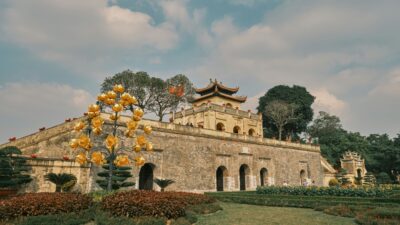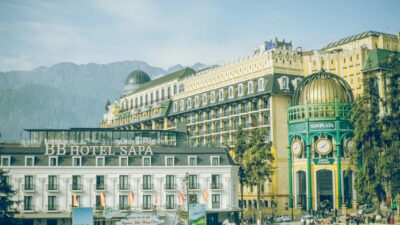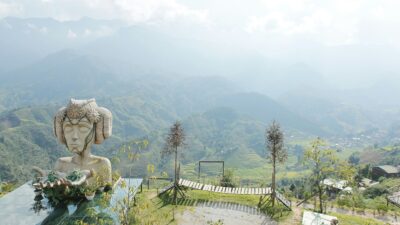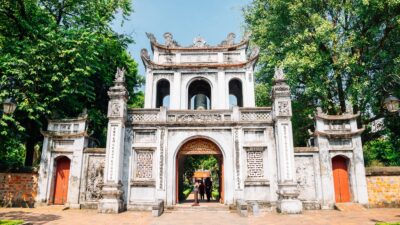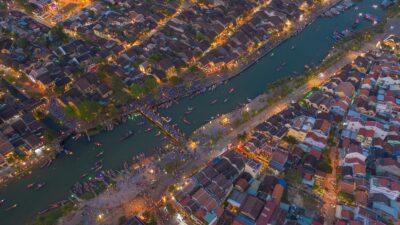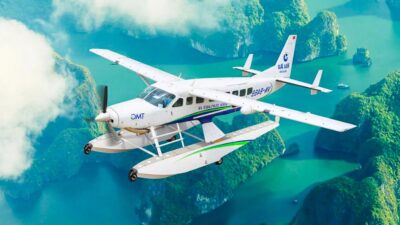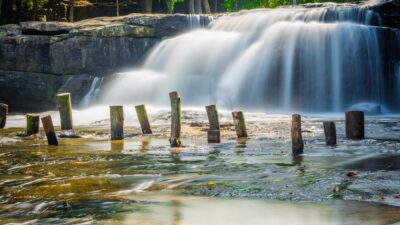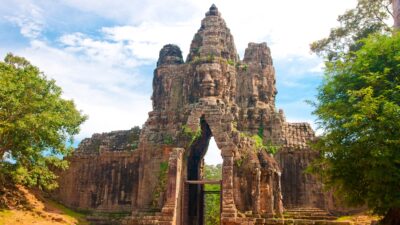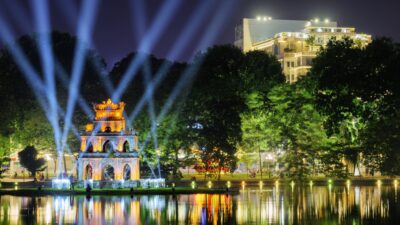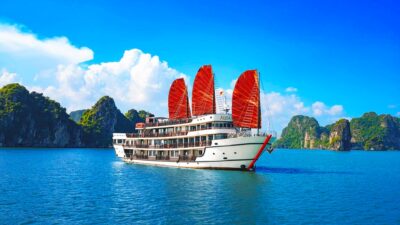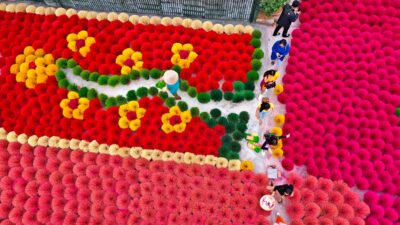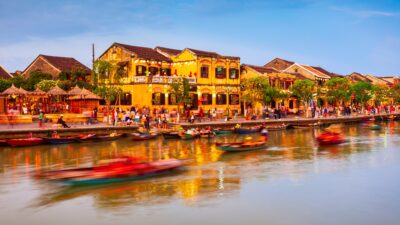Dreaming of Ninh Binh’s breathtaking landscapes, often called “Halong Bay on Land”? If you’re an Indian traveller planning a trip to Vietnam, understanding the best time to visit Ninh Binh is key to an unforgettable experience. While Ninh Binh offers unique beauty year-round, the ideal time truly depends on what you want to see and do.
This guide will break down each season, highlighting weather patterns, stunning landscape transformations (from emerald green to golden harvest!), unique activities, and cultural events. Knowing when to visit Ninh Binh – located in Northern Vietnam and easily accessible from Hanoi – allows you to make the most of its majestic limestone karsts, tranquil rivers, and rich history, ensuring a memorable vacation tailored to your preferences.

Understanding Ninh Binh’s Climate: A Snapshot
To choose the best time to visit Ninh Binh, understanding its climate is essential.
- Location: Northern Vietnam, within the Red River Delta region.
- Climate Type: Ninh Binh features a tropical monsoon and humid subtropical climate.
- Four Distinct Seasons: Expect clear transitions between Spring, Summer, Autumn (Fall), and Winter.
- General Weather: Generally warm year-round.
- Average Temperature: Around 23.5°C (74.3°F).
- Average Humidity: High, typically between 80-85%.
- Key Seasonal Cycles:
- Wet/Rainy Season: Usually runs from May to October, peaking between July and September. Expect higher humidity, frequent (often heavy) rain showers, and a small possibility of localized flooding.
- Dry Season: Generally from November to April. This period sees lower humidity, significantly less rainfall, and often clearer skies.
These seasonal shifts dramatically affect your Ninh Binh experience: influencing landscape colors (green vs. golden rice), suitability for outdoor activities like boat tours, cycling, and hiking, crowd levels, and the timing of vibrant cultural festivals.
Best time to visit Ninh Binh Through the Seasons
Let’s break down each season to help you determine the best time to travel to Ninh Binh based on your preferences. Each season in Ninh Binh comes with its attributes that enhance the travel experience.
Ninh Binh in Spring (February – April/Early May)
Often called the “spring awakening period”, this season brings delightful weather.
- Weather: Mild, pleasant, warm, sometimes cool. From February to early May, expect very little rain. Occasional light rain or drizzle is possible. Morning and evening mist can create a wonderfully “poetic and romantic scene”.
- Temperature: Approx. 18°C – 30°C (64°F – 86°F). Specifically, Feb-early May often sees comfortable temps between 20°C – 28°C (68°F – 82°F).
- Landscape: Nature comes alive! Expect vibrant green rice paddies, blooming flowers, and lush vegetation everywhere.
- Activities & Highlights:
- Ideal weather for all outdoor activities: boat tours in Tam Coc & Trang An, cycling through villages, exploring Cuc Phuong National Park (catch the amazing butterfly season from late April to May).
- Perfect time for visiting pagodas (Bai Dinh Pagoda) and temples (Thai Vi Temple).
- Festivals: Experience the festive air following Tet (Lunar New Year – check dates). Key events include the Bai Dinh Pagoda Festival, the Hoa Lu Festival (held 8th-10th day of the 3rd lunar month), and the Trang An Traditional Festival (18th day of the 3rd lunar month).
- Best For: Nature lovers, photographers seeking vibrant green colors, and those appreciating pleasant weather and cultural festival experiences.
Travel Tips: Pack layers including a light jacket for cooler mornings/evenings. Comfortable walking shoes are essential. Be aware this is a popular season, especially around Tet and festivals; book accommodation and tours well in advance. Try local specialties like mountain goat meat (`De Nui`) and rice crust (`Com Chay`).

Ninh Binh in Summer (May – August)
Summer showcases Ninh Binh’s vibrant life, but comes with heat and humidity.
- Weather: Hot and humid, with sunny days punctuated by frequent, often heavy, afternoon or evening thundershowers.
- Temperature: Ranges from approx. 26°C – 38°C (79°F – 100°F), feeling hotter due to humidity.
- Landscape:
- Golden Rice Harvest (Tam Coc): This is a major draw! The fields typically turn a stunning golden yellow from late May to mid-July. The view from Hang Mua (Mua Caves) viewpoint during this time, blending golden fields with green surroundings, is breathtaking.
- Lush green forests remain vibrant. Lotus flowers bloom beautifully in June, especially around Ngoa Long Mountain and Mua Cave areas.
- Activities & Highlights:
- Witnessing and photographing the iconic golden rice harvest in Tam Coc.
- Boat tours in Trang An are still enjoyable; exploring the limestone caves offers welcome cool relief from the heat.
- Visit Van Long Nature Reserve. Explore Mua Caves early morning or late afternoon to avoid peak heat. Enjoy delicious tropical fruits like mangoes and lychees.
- Best For: Budget travelers (potentially lower prices outside peak harvest), photographers seeking lush greenery or the golden harvest, and those who are comfortable with tropical heat and humidity (similar to parts of India during summer).
- Considerations: Prepare for intense heat, high humidity, and sudden rain. Plan strenuous activities for cooler parts of the day. While international crowds might be lower, late June/July can see more domestic tourists due to school holidays.
Travel Tips: Pack light, breathable clothing (cotton recommended). Bring a waterproof jacket or umbrella, high SPF sunscreen, hat, sunglasses, and insect repellent. Stay well-hydrated. Book accommodations early if traveling during Vietnamese school holidays. Try dishes like fried crab with piper lolot (`Cua Rang La Lot`) and Van Long grilled snakehead (`Ca Nuong Van Long`).
Ninh Binh in Autumn (September – November)
Often considered the absolute best time to visit Ninh Binh by many travellers.
- Weather: Generally fantastic! Expect mild, cool, comfortable, and mostly dry weather with clear blue skies. Sunlight is less harsh than in summer. October and November offer an even more delightful cool and crisp climate with just a hint of dry coldness.
- Temperature: Comfortable range of approx. 18°C – 30°C (64°F – 86°F).
- Landscape:
- Second Golden Rice Harvest: Another chance to see the stunning golden fields, typically from September to early October.
- “Com” Harvest: From August to September, witness the unique harvest of young sticky rice (“com”) and sample this local delicacy in markets and restaurants.
- Water lilies bloom beautifully, and lotus flowers add a touch of “dreamy purple” to the waterways. Admire the soft sunlight filtering through limestone caves during boat trips in October/November. Clear blue skies.
- Activities & Highlights:
- Perfect weather for all activities: cycling through golden paddies, hiking Mua Caves, boat tours in Tam Coc and Trang An.
- Excellent for photography. Explore Hoa Lu ancient capital and Bai Dinh Pagoda comfortably.
- Discover Vietnam’s jungle and wildlife in national parks like Cuc Phuong National Park, Thung Nham Bird Park, or the Ninh Binh Bear Sanctuary.
- Festivals: The Trang An Festival in September celebrates cultural heritage. The Mid-Autumn Festival (check specific dates) is also celebrated with lanterns and mooncakes.
- Best For: Photographers, active travelers, and practically anyone seeking a memorable experience with fantastic weather, stunning golden scenery, and manageable crowds (less than peak Spring).
Travel Tips: Pack comfortable clothing with a light jacket for cooler evenings. Sunscreen and a hat are still useful. While potentially less crowded than spring, autumn is popular; booking services in advance is recommended. Try local specialties like swamp eel salad (`Goi Luon`) and Dong Giao pineapple.
Ninh Binh in Winter (December – February)

Winter offers a different, quieter charm.
- Weather: Cool to cold, and generally dry, though often overcast with potential for fog and drizzle, especially in the mornings. Temperatures can sometimes drop significantly, potentially reaching 5°C – 7°C (41°F – 45°F) in January, the coldest month.
- Temperature: Typically ranges from approx. 10°C – 23°C (50°F – 73°F).
- Landscape: While the vibrant rice paddies are gone (fields are usually fallow or newly planted), winter brings the unique beauty of reed flowers blooming, covering parts of the landscape in a “pure white color,” resembling a “silky white scarf.” The misty, foggy conditions create a unique, poetic atmosphere.
- Activities & Highlights:
- Ideal for exploring historical sites (Hoa Lu, Bai Dinh Pagoda) and caves (Trang An, Mua Caves) without the heat and humidity.
- Enjoying a peaceful, quiet atmosphere with significantly fewer tourists.
- Hiking can be pleasant in the cool weather (dress warmly!). Boat tours offer ethereal, misty views.
- Warm up with local winter dishes: try a hot bowl of goat soup (`chao de`), a tasty meal of roasted goat (`de nuong`), and perhaps some fiery local Kim Son wine. Enjoy Gao fruit and eel vermicelli (`Mien Luon`).
- Best For: Budget travelers (lower prices likely), those seeking peace and quiet, photographers interested in atmospheric misty landscapes, and travelers who enjoy or prefer cooler weather for sightseeing.
- Considerations: Not the season for green or golden rice fields. Overcast skies are common. Keep an eye on the weather forecast, as the chilly weather “might make you feel unwell” if unprepared.
Travel Tips: Pack warm clothing is essential: layers, sweaters, jackets, jeans, scarves, socks, and possibly gloves. Bring moisturizer for potentially dry air.
Sample Ninh Binh Itineraries
Conclusion
There’s truly no single “absolute best time to visit Ninh Binh” – the perfect season depends entirely on your personal preferences for weather, scenery (golden vs. green), desired activities, tolerance for crowds, and budget.
Weigh the unique charms and considerations of each season outlined in this guide. Whether you dream of gliding through golden rice fields in autumn, exploring vibrant green landscapes in spring, finding tranquility amidst winter mists, or embracing the lushness of summer, Ninh Binh’s captivating beauty and rich culture will welcome you.
As an Indian tourist, choosing the right time ensures your Vietnamese adventure in this stunning “Halong Bay on Land” is nothing short of unforgettable!
Ready to plan? Contact Vietnam Story experts for tailor-made itineraries and the latest advice.

